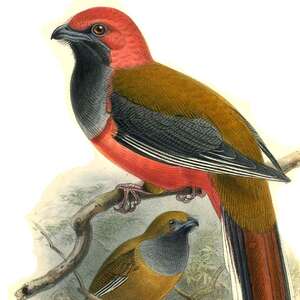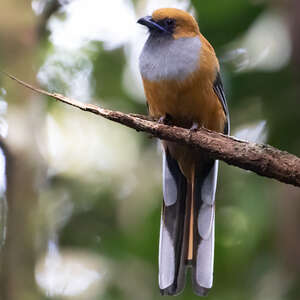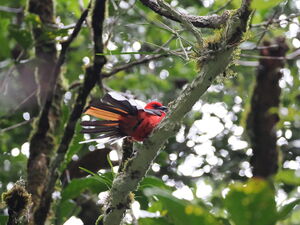Whitehead's Trogon
Harpactes whiteheadi - Trogon de Whitehead
Identification
It was Richard Bowdler Sharpe, a British ornithologist (1847-1909) who described this trogon and named it Harpactes whiteheadi, in honour of John Whitehead (1830-1899), a British explorer who discovered this species during his travels to Borneo in 1884. Bird enthusiasts will recognize the same strain of name with the Firecrest, whose scientific name is Sitta whiteheadi, discovered by the same Whitehead in 1882. Whitehead's Trogon is 30 cm long with distinct dimorphism in appearance; the male has black lores and throat, a strong blue-cobalt beak with black tip; dark brown iris with a large blue-cobalt orbital ring. Forward, crown and nape are vivid red; chest is grey-silver and in contrast with the red belly; mantle, scapulars and back are brightly shining chestnut-brown. Black coverts have thin, horizontal white vermiculations; the remiges remain black, distinctly marked with white at the emarginations. Its central rectrices are chestnut, darker than chestnut-brown back, barred with black at the tip; the second and third pairs of lateral rectrices are black, while the outer rectrices which the trogon shows when facing forward are white; if Whitehead's Trogon slightly opens its outer rectrices, it will show its black lateral rectrices. The female has light brown to ochre head, still black lores and throat, the same blue colouration observed on the beak and orbital ring as with the male. The grey-silver chest gives way to an ochre-yellow belly; the nape and mantle are chestnut brown, while the back and rump are of the same yellow hue as the belly. The coverts are dark brown, with wide chamois vermiculations; the black remiges are marked with white at the emarginations.The flight feathers are similar to those of the male. Juveniles have been little observed, they are probably brownish with diffuse white spots and will eventually take on the striking red of the male or cinnamon brown of the female.
Subspecific information monotypic species
Foreign names
- Trogon de Whitehead,
- Trogón de Borneo,
- republicano-de-bornéu,
- Graubrusttrogon,
- fehérfejű malájtrogon,
- Whiteheads Trogon,
- Trogone di Whitehead,
- whiteheadtrogon,
- Rødhettetrogon,
- dravčík sivoprsý,
- trogon šedoprsý,
- Kinabalutrogon,
- borneontrogoni,
- trogon de Whitehead,
- sędzioł czarnobrody,
- Серогрудый азиатский трогон,
- Luntur kalimantan,
- ノドグロキヌバネドリ,
- 灰胸咬鹃,
- kinabalutrogon,
- 灰胸咬鵑,
Voice song and call
Habitat
Dietfeeding habits
Reproduction nesting
Geographic range
Threats - protection
IUCN conservation status
concern
in the Wild
threatened
evaluated
Near Threatened or NT, Whitehead's Trogon has a small and fragmented distribution area (18,600 km2 according to Birdlife) and is becoming increasingly rare to observe around Mount Kinabalu in Malaysia, although the region used to be its stronghold a few years ago. Its population is certainly declining, and the list of reasons stays the same: demographic increase, deforestation, intensive farming, pollution and uncontrolled tourism. Our lack of knowledge about Whitehead's Trogon doesn't help either; is its decline inevitable?
Sources of information
- IOC World Bird List (v15.1), Gill, F and D Donsker (Eds). 2025-12-07.
- A Natural history of the Trogonidae, Joseph M.Forshaw Albert Earl Gilbert
- Vol. 6 - Handbook of the Birds of the World, Josep del Hoyo-Andrew Elliott-Jordi Sargatal
- Scientific Birds Names, James A.Jobling
- xeno-canto, Sharing bird sounds from around the world,
- ARKive, Christopher Parsons
- Avibase, Lepage Denis
- HBW Alive,
- The internet Bird Collection,
- Wikipédia, Wikipedia, The Free Encyclopedia
- Oriental Bird Club,
Other sources of interest
 Specification sheet created on
04/08/2023 by Anne et Gabriel Leboff
Specification sheet created on
04/08/2023 by Anne et Gabriel LeboffTranslation by AI Oiseaux.net
© 1996-2025 Oiseaux.net
- Accipitriformes
- Aegotheliformes
- Anseriformes
- Apodiformes
- Apterygiformes
- Bucerotiformes
- Caprimulgiformes
- Cariamiformes
- Casuariiformes
- Charadriiformes
- Ciconiiformes
- Coliiformes
- Columbiformes
- Coraciiformes
- Cuculiformes
- Eurypygiformes
- Falconiformes
- Galliformes
- Gaviiformes
- Gruiformes
- Leptosomiformes
- Mesitornithiformes
- Musophagiformes
- Nyctibiiformes
- Opisthocomiformes
- Otidiformes
- Passeriformes
- Pelecaniformes
- Phaethontiformes
- Phoenicopteriformes
- Piciformes
- Podargiformes
- Podicipediformes
- Procellariiformes
- Psittaciformes
- Pterocliformes
- Rheiformes
- Sphenisciformes
- Steatornithiformes
- Strigiformes
- Struthioniformes
- Suliformes
- Tinamiformes
- Trogoniformes














